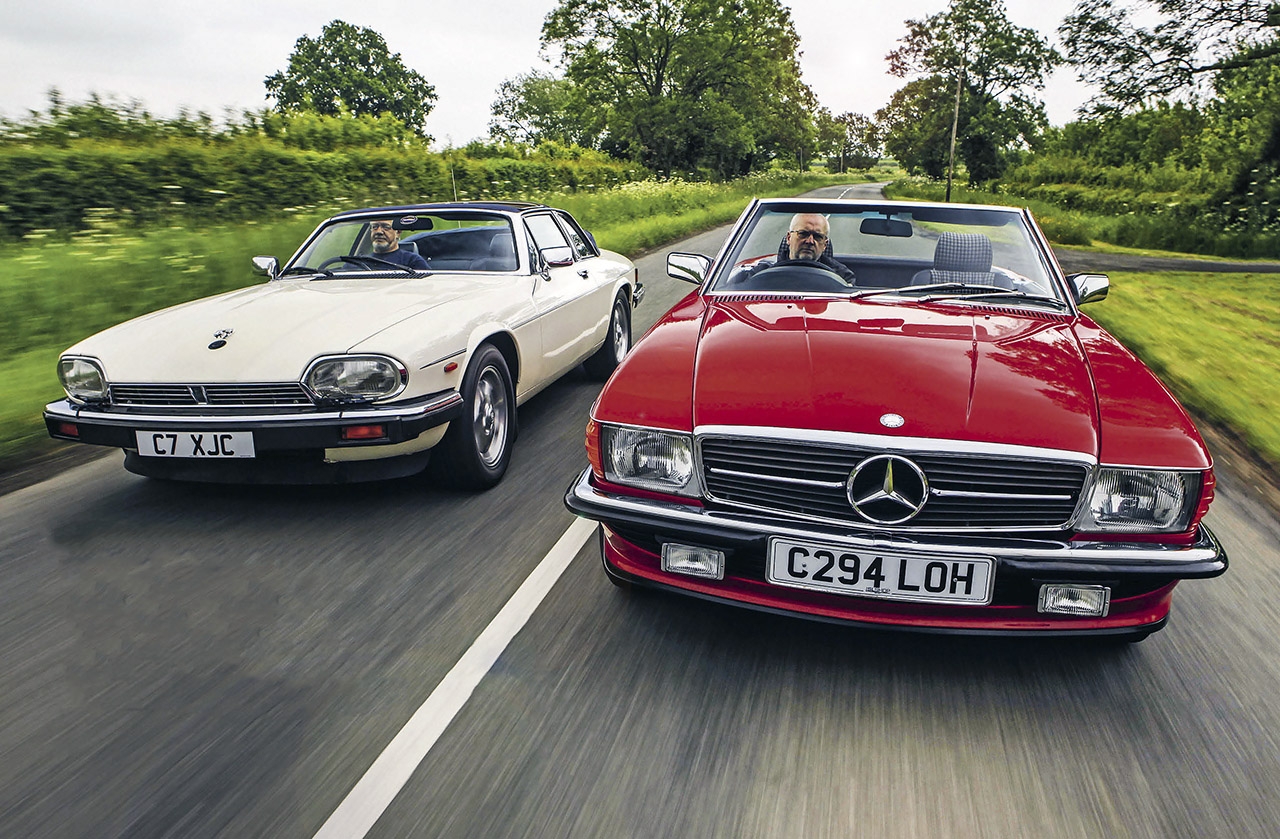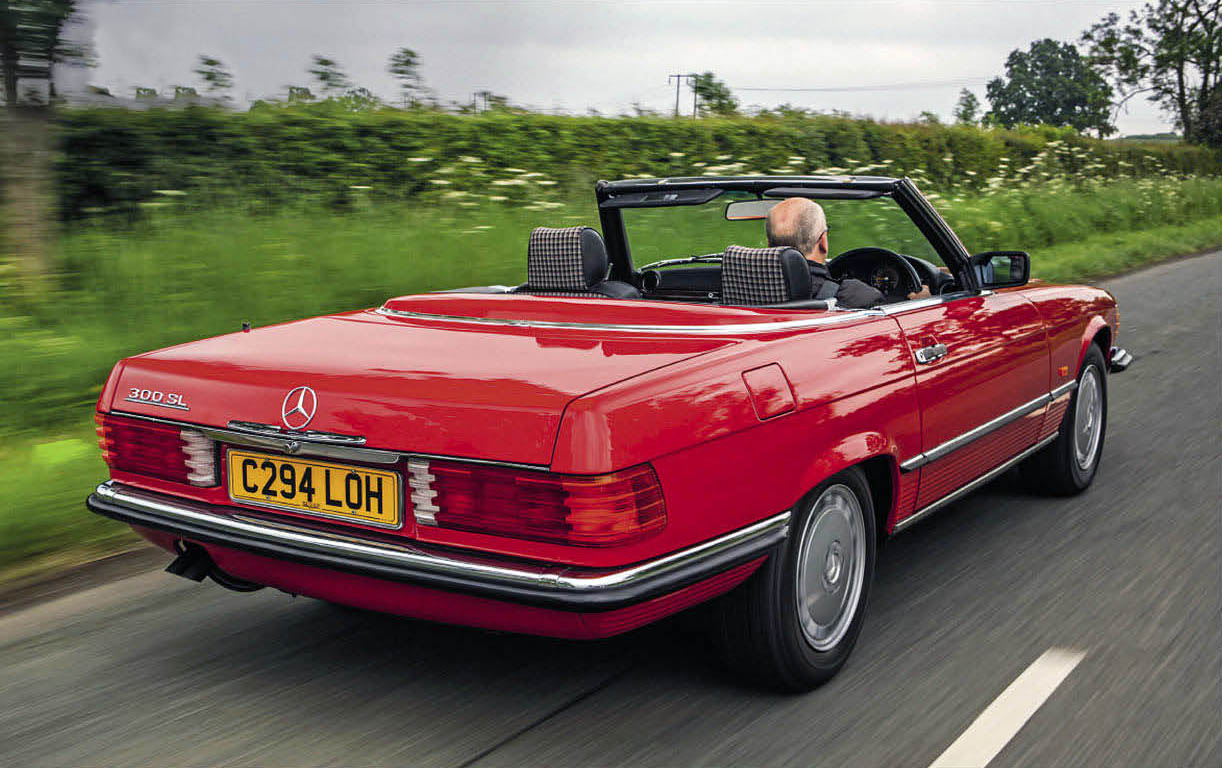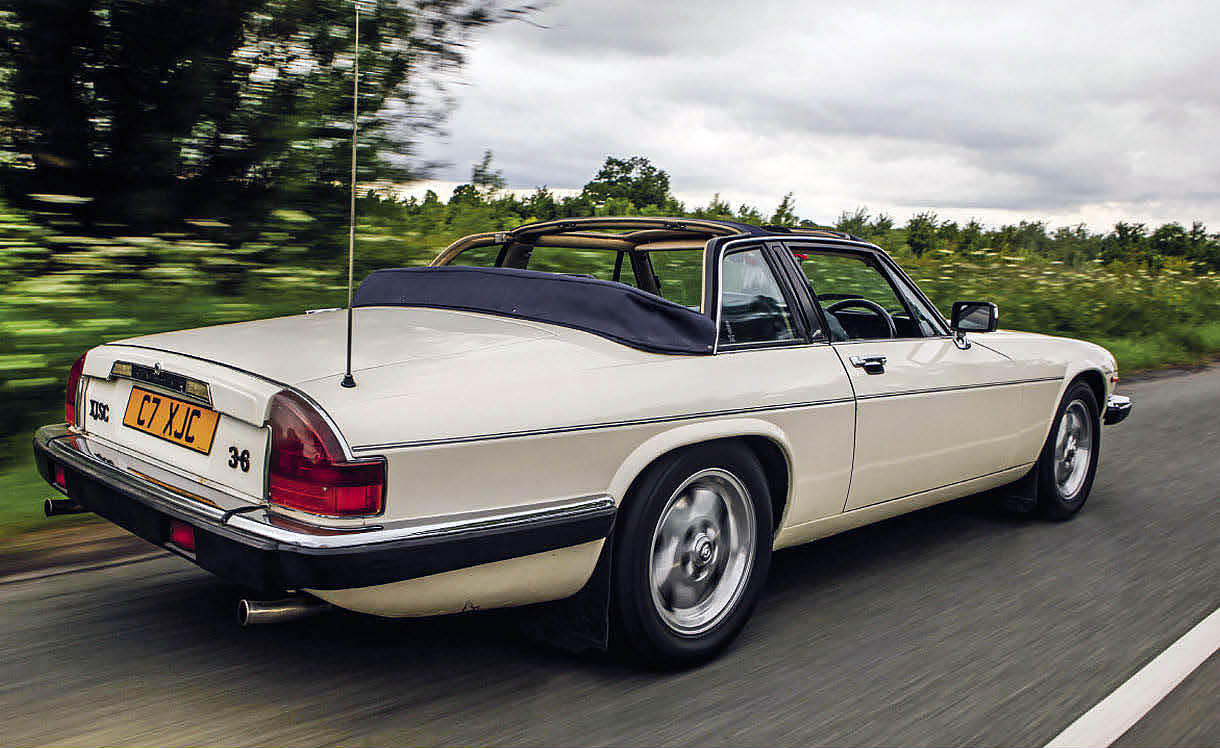
Mercedes-Benz SL R107 vs Jaguar XJ-SC – Built for Sunset Boulevard – Cheap roadsters with a touch of class. Bargain GTO alternatives – drop-top battle. In the mid-’80s there were few ways for quality car buyers to mess up their hair. Russ Smith samples the two main rivals, Jaguar’s XJ-SC and the Mercedes-Benz 300SL R107. Photography Tony Baker.
When buying a car for ‘best’, it seems a shame not to make the experience that bit more special and let some sunshine in. I’m surely not alone in seeing a full-length Webasto sunroof as a minimum requirement in a classic. And the more – and easier – the top drops, the better life is. There’s a premium to pay, of course, but it’s worth every penny, even if we only get around six days a year to enjoy it to the full. All of which made the late 1970s and early ’80s something of a barren wasteland for fresh-air freaks, especially in the well-to-do corner of the market. If you couldn’t make the price-tag of a Volante or Corniche, the choice was either one Of the dwindling collection of ancients that were struggling on with the automotive equivalent of Botox injections, the new halfway-house trend Of ‘targa’ tops… or a Mercedes-Benz SL.

Even Jaguar, which had an extensive and impressive open-topped back catalogue, built its last in 1973 with the demise of the Jaguar E-type. It would be a full 10 years until the comeback, the Jaguar XJ-SC, a year after Porsche finally relented and properly chopped the roof off the 911. Some might also point out that the R107 breed of Mercedes SL was knocking on a bit by then, having been introduced in 1971. But there’s something timeless about the SL. The styling – by Paul Bracq and others – started out conservative and carved its own niche, protected from the whims of fashion for the 18 years it stayed in production, and remaining to all but trained eyes the same throughout that time.
Our featured example is a 1987 300SL, the famous name last used in 1963 having been revived for the smallest-engined of the four models for the 1986 model year, which coincided with the last significant changes to the cars before production ended in July 1989.
Those included slightly firmer suspension, better brakes and a swifter-changing auto ’box than on earlier models. No surprise, then, that the 300SL has become the most sought-after of R107s, at least in petrol-price-obsessed Britain, with the perfect balance of performance and frugality plus the knowledge that it enjoys the fruits of15 years of steady technological improvement. There was even galvanising on some of the panels. Spotters will want to know that they are distinguished by deeper front spoilers, in body colour rather than black.
Of course, the Jaguar XJ-S was no spring chicken itself by the time the “the cabriolet” roofed SC model was launched in 1983. But losing those controversial rear buttresses breathed new life into Malcolm Sayer’s design, even if the XJ-SC’s strength-retaining roof framework did remind everyone of the Triumph Stag. For its first two years, the XJ-SC could be had only with the 3.6-litre 24-valve AJ6 engine that Jaguar also introduced in 1983, broadening the coupé’s market in an affordable direction. Not only was it around 10% cheaper than the V12 model, but it also drank a lot less – and without being appreciably slower in most circumstances. Motor Sport rated it: ‘Even more appealing than the brute power of the V12.’
Despite all of that, and unlike the SL, the XJ-SC remains a rarefied creature, especially in 3.6-litre form. Only 714 were built with right hand drive, and Graham Greenwood’s Nimbus White example is one of a mere 85 of those to have been ordered with an automatic gearbox – a four-speed, as is that of the Mercedes-Benz.
The Jaguar’s targa-style roof arrangement was a compromise born of necessity: at that stage the basic structure simply wasn’t strong enough to support a full convertible. When, five years later, Jaguar did manage that, it was only after a hefty 60kg of strengthening had been engineered into the bodyshell. That difference is enough to make the XJ-SC feel more nimble than its successor, though that alone has never been enough to excite buyers. Nor does the simple truth that, when driving an XJ-SC with its top down, it does feel like a convertible; you barely notice the roof bar, and most of us drive ‘touring’ ragtops with the windows up anyway. The only grumble, which also applies to the full convertible, is that the lowered hood stands proud of the deck and restricts rearward vision.
That’s not a gripe ever aimed at the Mercedes SL, whose cleverly designed top folds out of sight under a panel ahead of the bootlid. The Merc’s roof takes just as long to lower and erect as the Jaguar’s, but pulls very taut and is free from any of the flap or ballooning suffered by some soft-tops at speed. Thumbs up for the XJ-SC on that score, too: those two lift-out solid panels bypass that problem completely. You’ll get a little more hair-ruffling from the Mercedes with the top down, but with hoods erected both cars’ cabins are equally civilised places to be. And with decent-sized windows, particularly on the Jag, neither suffers from that closed-roof drop-top claustrophobia.
A more marked difference in character comes from the cars’ relative seating positions. In the Mercedes you sit high and quite upright, on seats with firm and flat bases but supportively rounded backs. It’s comfortable and gives a commanding view that makes the car feel smaller and easier to place. In the Jaguar, you’re lower and it feels sportier, more laid-back in the seat. That’s nice in its own way, but comes at the expense of any idea of where the car’s corners are – perhaps it might better suit a taller driver.
Greenwood’s XJ-SC is also unusual in having factory-fitted rear seats, like those in the hardtop ‘Princess Diana’ SC that lives in Jaguar’s Heritage collection. Because chairs in the back were never approved for this model, Browns Lane will tell you they were all sold with luggage racks in the rear rather than seats, but Greenwood knows of three others. They may only suit small children, but that does offer the Jag some advantage over this Benz, which has only a luggage platform in the back. SLs had the option of token rear seats, but they are only of much use if the driver and passenger are short enough to slide the seats forward a decent amount.
With accommodation dealt with, which of these cars is going to appeal more to the enthusiast? The flowing, swoopy lines of the Jaguar border on elegance so, along with that extra 600cc under the bonnet, that surely makes it the driver’s favourite here. But is that enough?

More upright and square, the SL packs a lot more ‘bling’ than the Jag, but in a way that makes it appear expensive – a Rolex of a car. At the same time, it looks more at home in a sports club car park than a sports car race. Mercedes had long before given up the pretence that SL meant ‘lightweight sports’. By the R107 era those letters had more meaning as a brand, and at nearly one and a half tonnes the 300SL is neither light nor sporty, nor that tactile either. What it is, however, is a very pleasant and easy car to drive, with sufficient power to make it enjoyable but not enough to challenge its chassis and get you into trouble. Frustratingly, there’s no feel to the light power steering, but the car goes exactly where you point it, so is hard to fault. A little safe understeer eventually comes into play, but only beyond the limits that most drivers will push it to; the majority will find it delightfully neutral.
Not that the Jaguar has much to shout about with regards to tactility. Initially you get a false impression from its more heavily weighted steering, before realising you are being asked to work harder without the reward of any extra feel. The iPod inside my head starting playing Pink Floyd’s Comfortably Numb, a title that sums up the handling perfectly. It’s a match for the Mercedes-Benz on most roads, but the narrower and twistier they become, the less you want to tackle them in the XJ, despite the benefit of the more lithe ride that is a Jaguar trademark. The greater length – which seems to be mostly bonnet – combined with extra effort and less awareness of where the car’s extremities lie, are stresses the SL doesn’t subject you to. Even with its lack of feedback, the Mercedes has a crispness of reaction that enables you to place it with inch-perfect precision.
You also start to appreciate that, while the SL is no lightweight per se, it is in comparison to the XJ-SC, which, metaphorically speaking, is no stranger to Coventry’s pie shops. Packing an extra 400lb in weight takes away just about all of the Jaguar’s 37bhp advantage. It may still just hold sway in outright top speed and 0-60mph sprint, but in most mid-range acceleration measures the SL matches or betters the SC.
Part of that is down to the Mercedes engine’s greater willingness to rev, combined with a smarter response to throttle inputs. It also feels better matched to the automatic gearbox, which benefits from a ‘Sport’ mode to sharpen shifts and hang on to each gear longer. In contrast, the Jaguar momentarily pauses for thought when asked to do something. Not the twiddle-your thumbs wait of turbo lag, but a kind of Hugh Grant stutter before the powertrain heaves into action. Once it does, you feel the push of greater torque, but by then you are playing catch-up.
Much of it seems to be down to the automatic ’box, and indeed tests prove the more common manual 3.6 XJ-SC to be a quicker animal. The transmission boot is on the other foot with the SL; most were sold with automatic gearboxes in the first place, and in particular with post-1985 models such as this there is no real advantage to having a manual ’box.
The Jaguar does bite back when you open the bonnets. The Mercedes ‘six’ merely looks big, a black lump with quite possibly the largest air filter housing ever made that doesn’t have a big-block V8 beneath it. You’ll maybe check the oil and quietly close the bonnet without calling your petrolhead friends over for a look. Jaguar made a bit more effort to dress up its replacement for the legendary XK unit – as if it’s going out on the town. There are polished fins on the cam covers and a prominent Jaguar logo for starters, and all the fuel-injection gubbins is on show. It’s a bonnet you can lift with confidence until you tire of explaining why the 3.6 really is a better choice than the V12.
The answer to our quest to decide which of these cars is better should be pretty clear by now. A few years ago I refereed a similar match between these cars’ predecessors, the E-type and ‘Pagoda’ SL. That proved a walkover for the English team, but the Germans have pulled one back in the second half: the 300SL is simply a nicer car to drive, and feels better built too.

There is a small flaw in the argument, however, and that is price. Despite a recent renewal of interest in open-topped XJ-Ss, a good 3.6 SC will still cost you around 40% less than a 300SL in similar condition. After a brief pause for thought, my answer to that financial conundrum would be to settle for a slightly less good SL, perhaps picked up at auction, where bargains can still be found. So there you are; I’m finding excuses to choose the Mercedes. It’s a car that leaves its mark on you like that.
Unusually, the XJ-SC looks even better with the roof on. Below, l-r: sumptuous wood-and-leather interior; traditional ‘barrel’ gauges.
Superbly engineered hood is flap-free, but a powered option was never offered. Above, l-r: cloth and vinyl inside; superbly clear dials.
‘WITH DECENT-SIZED WINDOWS, NEITHER SUFFERS CLOSED-ROOF CLAUSTROPHOBIA’
Losing buttresses pleased the anti-XJ-S lobby, but SC lacks clean look of 1988 full convertible. Below: neat chrome mirror controls; attractive twin-cam ‘six’.
JAGUARXJ-SC 3.6
Sold/number built 1983-1987/1148
Construction steel monocoque
Engine all-alloy, dohc 3590cc ‘six’, Bosch D-Jetronic fuel injection
Max power 225bhp @ 5300rpm
Max torque 240lb ft @ 4000rpm
Transmission four-speed automatic (or five-speed manual), RWD
Suspension independent, at front by semitrailing wishbones, coil springs, telescopic dampers rear lower wishbones, driveshafts as upper links, twin coil/damper units.
Steering power-assisted rack and pinion
Brakes discs, vented at front, with servo
Length 15ft 7in (4765mm) Width 5ft 10 ½ in (1790mm) Height 4ft 2in (1265mm)
Wheelbase 8ft 6in (2590mm)
Weight 3660lb (1662kg)
0-60mph 7.8 secs
Top speed 130mph
Mpg 20
Price new £22,395
Price now £3-9000
Thanks to Graham Greenwood, Steve Jordan,
Jaguar Drivers’ Club: www.jaguardriver.co.uk
With no T-bar and the hood hidden beneath a body-coloured cover, the SL is an elegant roadster. Above: sweet-revving ‘six’; chunky details.
MERCEDES-BENZ 300SL
Sold/number built 1985-1989/13,742
Construction steel monocoque
Engine iron-block, alloy-head, sohc 2962cc ‘six’, Bosch KE-Jetronic fuel injection
Max power 188bhp @ 5700rpm
Max torque 192lb ft @ 4400rpm
Transmission four-speed automatic (or five-speed manual), RWD
Suspension independent, at front by double wishbones rear semi-trailing arms; coil springs, telescopic dampers f/r
Steering power-assisted recirculating ball
Brakes discs, vented at front, with servo
Length 14ft 5in (4390mm) Width 5ft 10 ¼ in (1780mm) Height 4ft 5in (1340mm)
Wheelbase 8ft 1in (2460mm)
Weight 3248lb (1475kg)
0-60mph 8.4 secs
Top speed 126mph
Mpg 24
Price new £24,840
Price now £3-15,000
Thanks to Sam Bailey and Andy Bufton,
The SL Shop: www.theslshop.com
{CONTENTPOLL [“id”: 15]}





